Themed collection Small Molecule Activation

Small molecule activation
Welcome to this themed issue of Dalton Transactions entitled “Small molecule activation”.

Dalton Trans., 2016,45, 14419-14420
https://doi.org/10.1039/C6DT90140A
Insights into small molecule activation by multinuclear first-row transition metal cyclophanates
The rational design of trimetallic transition metal clusters supported by a trinucleating cyclophane ligand, L3−, and the reactivities of these complexes with dinitrogen and carbon dioxide are discussed.

Dalton Trans., 2016,45, 14499-14507
https://doi.org/10.1039/C6DT01857B
On the non-innocence of “Nacnacs”: ligand-based reactivity in β-diketiminate supported coordination compounds
While β-diketiminate (BDI or ‘nacnac’) ligands have been widely adopted to stabilize a wide range of metal ions in multiple oxidation states and coordination numbers, in several occurrences these ligands do not behave as spectators and participate in reactivity.
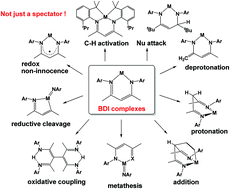
Dalton Trans., 2016,45, 14462-14498
https://doi.org/10.1039/C6DT02013E
Water oxidation using earth-abundant transition metal catalysts: opportunities and challenges
Catalysts for the oxidation of water are a vital component of solar energy to fuel conversion technologies. This Perspective summarizes recent advances in the field of designing homogeneous water oxidation catalysts (WOCs) based on Mn, Fe, Co and Cu.

Dalton Trans., 2016,45, 14421-14461
https://doi.org/10.1039/C6DT00809G
Nitrous oxide activation by a cobalt(II) complex for aldehyde oxidation under mild conditions
A new cobalt(II) complex reacts with N2O under mild conditions and it catalytically performs the oxidation of aldehydes.
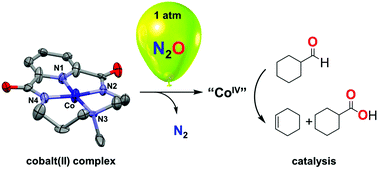
Dalton Trans., 2016,45, 14530-14533
https://doi.org/10.1039/C6DT01704E
Hydrogen peroxide activation by fluorophilic polyoxotungstates for fast and selective oxygen transfer catalysis
Polyoxometalate (POM)-based polyanionic fluorosurfactants self-assemble in hexafluoroisopropanol (HFIP) and activate hydrogen peroxide (H2O2), yielding efficient epoxidation of terminal alkenes.
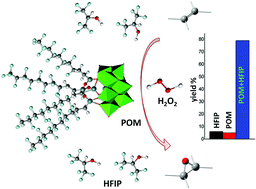
Dalton Trans., 2016,45, 14544-14548
https://doi.org/10.1039/C6DT01951J
Aerobic epoxidation catalysed by transition metal substituted polyfluorooxometalates
Polyfluorooxometalates with a nitro ligands, Q9[NaH2CuII(NO2)W17F6O55], are oxygen donors for epoxidation of alkenes and catalytic with O2 as terminal oxidant.
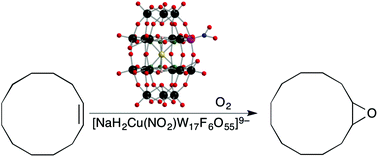
Dalton Trans., 2016,45, 14534-14537
https://doi.org/10.1039/C6DT01928E
A cobalt(II) iminoiodane complex and its scandium adduct: mechanistic promiscuity in hydrogen atom abstraction reactions
In addition to imidometal [Mn+![[double bond, length as m-dash]](https://www.rsc.org/images/entities/char_e001.gif) NR] units, transient metal–iminoiodane [M(n−2)+−N(R)
NR] units, transient metal–iminoiodane [M(n−2)+−N(R)![[double bond, length as m-dash]](https://www.rsc.org/images/entities/char_e001.gif) IPh] adducts have been demonstrated as a possible “second oxidant” responsible for the imido group transfer reactivity.
IPh] adducts have been demonstrated as a possible “second oxidant” responsible for the imido group transfer reactivity.

Dalton Trans., 2016,45, 14538-14543
https://doi.org/10.1039/C6DT01815G
Photochemical and electrochemical catalytic reduction of CO2 with NHC-containing dicarbonyl rhenium(I) bipyridine complexes
Efficient photochemical and electrochemical CO2-to-CO conversion using the N,O and N,S-NHC-containing dicarbonyl rhenium(I) bipyridine complexes is described.

Dalton Trans., 2016,45, 14524-14529
https://doi.org/10.1039/C6DT01686C
Divergent reactivity of platinum(II) and palladium(II) methylperoxo complexes and the formation of an unusual hemi-aminal complex
The 6,6′′-diaminoterpyridine palladium(II) methylperoxo complex eliminates methyl hydroperoxide and reacts with acetone to form a novel hemi-aminal palladium complex, whereas the analogous platinum(II) complex generates formaldehyde and a platinum(II) hydroxo complex.
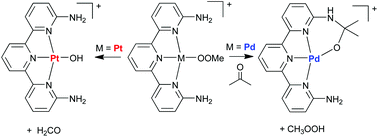
Dalton Trans., 2016,45, 14520-14523
https://doi.org/10.1039/C6DT01691J
Highly efficient dehydrogenation of formic acid in aqueous solution catalysed by an easily available water-soluble iridium(III) dihydride
Water-soluble cis-mer-[IrH2Cl(mtppms)3] selectively dehydrogenated formic acid with a TOF of 298 000 h−1, a final pressure of 140 bar, and a TONmax of 674 000.

Dalton Trans., 2016,45, 14516-14519
https://doi.org/10.1039/C6DT01695B
A mononuclear nonheme cobalt(III)–hydroperoxide complex with an amphoteric reactivity in electrophilic and nucleophilic oxidative reactions
A mononuclear nonheme cobalt(III)–hydroperoxide complex bearing a tetramethylated cyclam ligand, which is synthesized by the protonation of its corresponding cobalt(III)–peroxide complex, exhibits an amphoteric reactivity in electrophilic and nucleophilic oxidative reactions.
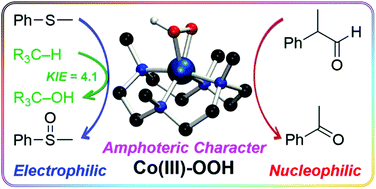
Dalton Trans., 2016,45, 14511-14515
https://doi.org/10.1039/C6DT01194B
Activation of CS2 by a “masked” terminal nickel sulfide
Activation of carbon disulfide (CS2) by “masked” terminal nickel sulfide, [K(18-crown-6)][(LtBu)Ni(S)], gives a trithiocarbonate complex. This result confirms the nucleophilicity of the sulfide ligand and expands the scope of reactivity for late metal sulfides.

Dalton Trans., 2016,45, 14508-14510
https://doi.org/10.1039/C6DT00885B
Palladium complexes with simple iminopyridines as catalysts for polyketone synthesis
A systematic study on iminopyridine palladium complexes demonstrates the relationship among NMR chemical shifts, ligand donor capability and catalytic performances.

Dalton Trans., 2016,45, 14609-14619
https://doi.org/10.1039/C6DT02992B
Solution or solid – it doesn't matter: visible light-induced CO release reactivity of zinc flavonolato complexes
Two types of zinc flavonolato complexes exhibit similar visible light-induced CO release reactivity in the solution and solid state.
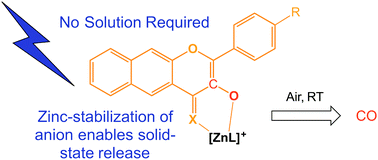
Dalton Trans., 2016,45, 14570-14580
https://doi.org/10.1039/C6DT01709F
Molybdenum dinitrogen complexes facially coordinated by linear tridentate PEP ligands (E = N or P): impact of the central E donor in trans-position to N2
The syntheses of new molybdenum dinitrogen complexes supported by the tridentate PEP ligands (E = N, P) prPP(Ph)P (2), prPPHP (3), PN(Ph)P (4) and prPN(Ph)P (5) are reported.
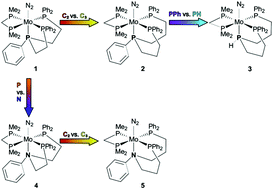
Dalton Trans., 2016,45, 14801-14813
https://doi.org/10.1039/C6DT02316A
Mechanistic insights from theory on the reduction of CO2, N2O, and SO2 molecules using tripodal diimine-enolate substituted magnesium(I) dimers
The mechanistic investigation of the reductive coupling vs. reductive disproportionation of CO2 using magnesium(I) dimers bearing tripodal ligands has been carried out using DFT computational methods.
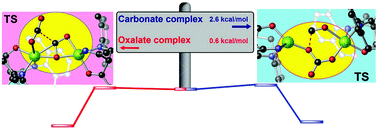
Dalton Trans., 2016,45, 14789-14800
https://doi.org/10.1039/C6DT02189A
Dinitrogen binding, P4-activation and aza-Büchner ring expansions mediated by an isocyano analogue of the CpCo(CO) fragment
Synthetic studies targeting an m-terphenyl isocyanide analogue of the unstable 16e−, S = 1 complex CpCo(CO) are reported (Cp = η5-C5H5).
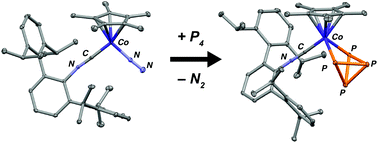
Dalton Trans., 2016,45, 14561-14569
https://doi.org/10.1039/C6DT02789J
Complexes of the tripodal phosphine ligands PhSi(XPPh2)3 (X = CH2, O): synthesis, structure and catalytic activity in the hydroboration of CO2
The coordination chemistry of Fe2+, Co2+ and Cu+ ions was explored with the ligands PhSi{CH2PPh2}3 (1) and PhSi{OPPh2}3 (2), so as to evaluate the impact of the electronic properties of the tripodal phosphorus ligands on the structure and reactivity of the corresponding complexes.
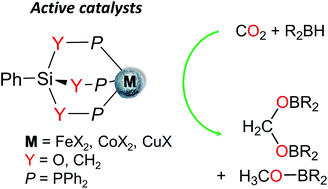
Dalton Trans., 2016,45, 14774-14788
https://doi.org/10.1039/C6DT02135B
Photoinduced hydrogen evolution with new tetradentate cobalt(II) complexes based on the TPMA ligand
New cobalt(II) complexes based on the TPMA ligand have been synthesized and characterized as molecular catalysts for photoinduced hydrogen evolution.

Dalton Trans., 2016,45, 14764-14773
https://doi.org/10.1039/C6DT01705C
A cobalt complex with a bioinspired molybdopterin-like ligand: a catalyst for hydrogen evolution
A cobalt complex using a bioinspired ligand, that mimics the molybdopterin cofactor, displays very good activity for electrochemical proton reduction in terms of turnover frequency, faradic yields and stability.

Dalton Trans., 2016,45, 14754-14763
https://doi.org/10.1039/C6DT01824F
Oxygen activation and catalytic aerobic oxidation by Mo(IV)/(VI) complexes with functionalized iminophenolate ligands
Dioxidomolybdenum(VI) complexes coordinated by functionalized bidentate iminophenolate ligands undergo oxygen atom transfer to PMe3 to yield molybdenum(IV) oxido phosphino species that readily react with molecular O2 to form molybdenum(VI) oxido peroxido complexes.
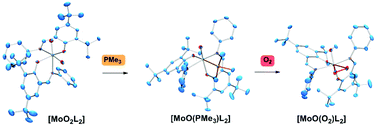
Dalton Trans., 2016,45, 14549-14560
https://doi.org/10.1039/C6DT01692H
Synthesis and catalytic applications of 1,2,3-triazolylidene gold(I) complexes in silver-free oxazoline syntheses and C–H bond activation
Novel triazolylidene gold(I) complexes were synthesized and activated by silver-free methodologies to generate catalysts for oxazoline synthesis and the C–H activation of arenes.
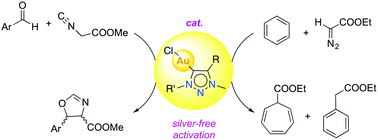
Dalton Trans., 2016,45, 14591-14602
https://doi.org/10.1039/C6DT02181F
Activation of heteroallenes by coordinatively unsaturated nickel(II) alkyl complexes supported by the hydrotris(3-phenyl-5-methyl)pyrazolyl borate (TpPh,Me) ligand
Activation of sulfur containing heteroallenes by nickel(II) alkyl complexes supported by the bulky hydrotris(3-phenyl-5-methylpyrazolyl)borate (TpPh,Me) ligand is described.

Dalton Trans., 2016,45, 14581-14590
https://doi.org/10.1039/C6DT01585A
Inorganic clusters with a [Fe2MoOS3] core—a functional model for acetylene reduction by nitrogenases
We report the first example of a wholly inorganic mimic of a part of the FeMoco active centre of nitrogenases.
![Graphical abstract: Inorganic clusters with a [Fe2MoOS3] core—a functional model for acetylene reduction by nitrogenases](/en/Image/Get?imageInfo.ImageType=GA&imageInfo.ImageIdentifier.ManuscriptID=C6DT01655C&imageInfo.ImageIdentifier.Year=2016)
Dalton Trans., 2016,45, 14620-14627
https://doi.org/10.1039/C6DT01655C
Sterically (un)encumbered mer-tridentate N-heterocyclic carbene complexes of titanium(IV) for the copolymerization of cyclohexene oxide with CO2
Titanium(IV) complexes bearing an unsubstituted tridentate bis(phenolate) N-heterocyclic carbene (NHC) were synthesized and structurally identified.

Dalton Trans., 2016,45, 14734-14744
https://doi.org/10.1039/C6DT01706A
Deposition of tetraferrocenylporphyrins on ITO surfaces for photo-catalytic O2 activation
Tetraferrocenylporphyrins have been successfully deposited on ITO electrodes for O2 photo-catalytic activation.

Dalton Trans., 2016,45, 14745-14753
https://doi.org/10.1039/C6DT01821A
Effective bromo and chloro peroxidation catalysed by tungsten(VI) amino triphenolate complexes
Amino triphenolate tungsten(VI) complexes have been prepared and they proved to be efficient catalysts in haloperoxidation reactions using hydrogen peroxide as a terminal oxidant and inorganic sources of halides.

Dalton Trans., 2016,45, 14603-14608
https://doi.org/10.1039/C6DT01780K
Small-molecule activation at Au(III): metallacycle construction from ethylene, water, and acetonitrile
Incorporation of the simple, readily available, building blocks ethylene, water and acetonitrile into Au(tpy)(OCOCF3)2 (tpy = 2-(p-tolyl)pyridine) in a one-step reaction leads to high yields of a new 6-membered ring gold(III) metallacycle complex.
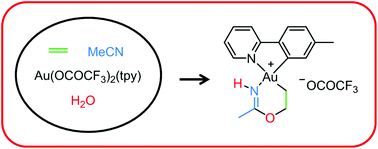
Dalton Trans., 2016,45, 14719-14724
https://doi.org/10.1039/C6DT01648K
Heterodinuclear Ni(II) and Cu(II) Schiff base complexes and their activity in oxygen reduction
New hetero- and homo-dinuclear Cu/Ni complexes electropolymerise potentiodynamically on glassy carbon electrodes and the polymers reduce dioxygen in water.

Dalton Trans., 2016,45, 14725-14733
https://doi.org/10.1039/C6DT01903J
Functional models of nonheme diiron enzymes: kinetic and computational evidence for the formation of oxoiron(IV) species from peroxo-diiron(III) complexes, and their reactivity towards phenols and H2O2
The reactivity of peroxo adducts towards H2O2 and phenols as functional catalase and RNR-R2 mimics is described.

Dalton Trans., 2016,45, 14709-14718
https://doi.org/10.1039/C6DT01598K
Low coordinate iron derivatives stabilized by a β-diketiminate mimic. Synthesis and coordination chemistry of enamidophosphinimine scaffolds to generate diiron dinitrogen complexes
The reduction of the iron enamido-phosphinimine complex under N2 leads to dinitrogen activation and cleavage of the phosphinimine linkage to generate a di-iron complex with a bridging imido moiety.

Dalton Trans., 2016,45, 14697-14708
https://doi.org/10.1039/C6DT01673A
Nickel-catalyzed release of H2 from formic acid and a new method for the synthesis of zerovalent Ni(PMe3)4
Ni(PMe3)4, which can be obtained by reaction of either Ni(py)4(O2CH)2 or Ni(O2CH)2·2H2O with PMe3, serves as a catalyst for the release of H2 from formic acid.
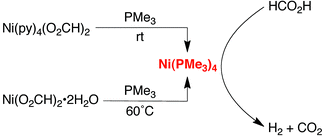
Dalton Trans., 2016,45, 14645-14650
https://doi.org/10.1039/C6DT01499B
Tailored design of ruthenium molecular catalysts with 2,2′-bypyridine-6,6′-dicarboxylate and pyrazole based ligands for water oxidation
A series of tailor-designed Ruthenium based water oxidation catalysts have been synthesized. By fine tuning of the catalyst structure, the turnover frequency was increased up to 500 s−1 and the stability over 6000 turnovers.

Dalton Trans., 2016,45, 14689-14696
https://doi.org/10.1039/C6DT01287F
High catalytic abilities of binuclear rhenium(I) complexes in the photochemical reduction of CO2 with a ruthenium(II) photosensitiser
Photocatalytic systems for CO2 reduction using a Ru(II) photosensitiser and dinuclear Re(I) diimine tricarbonyl complexes (Re(n)Re), in which diimine ligands are connected by alkyl chains of various lengths (–CnH2n–: n = 2, 3, 4, 6, 14), as catalysts were investigated.

Dalton Trans., 2016,45, 14668-14677
https://doi.org/10.1039/C6DT00996D
Aluminium salabza complexes for fixation of CO2 to organic carbonates
A highly stable and easy to synthesize aluminium complex bearing a flexible N2O2-donor salabza ligand (N,N′-bis(salicylene)-2-aminobenzylamine) in combination with tetrabutylammonium bromide forms an active binary catalytic system for the cycloaddition of CO2 to epoxides (TOFs 120–3434 h−1) under mild conditions (10 bar, 80 °C) and low catalyst loadings (0.05–0.2 mol%).

Dalton Trans., 2016,45, 14658-14667
https://doi.org/10.1039/C6DT01069E
Electrophilic phosphonium cations (EPCs) with perchlorinated-aryl substituents: towards air-stable phosphorus-based Lewis acid catalysts
A series of fluorophosphonium cations incorporating (C6Cl5) substituents, [Ph2PF(C6Cl5)][B(C6F5)4] 8, [PhPF(C6Cl5)2][B(C6F5)4] 9, and [(C6F5)PF(C6Cl5)2][B(C6F5)4] 10, were prepared and tested for air stability and catalytic activity.

Dalton Trans., 2016,45, 14651-14657
https://doi.org/10.1039/C6DT01339B
Raman spectroscopy of the N–N bond in rare earth dinitrogen complexes
Raman spectra have been collected on single crystals of over 20 different rare earth complexes containing reduced dinitrogen ligands to determine if these data will correlate with periodic properties or relative stability.
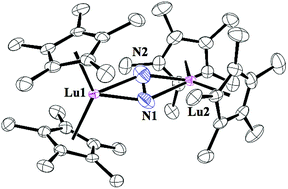
Dalton Trans., 2016,45, 14634-14644
https://doi.org/10.1039/C5DT04547A
Copper-induced ammonia N–H functionalization
The TpMsCu core has been found to bind ammonia as well as to promote stoichiometric or catalytic modification of the ammonia N–H bond.
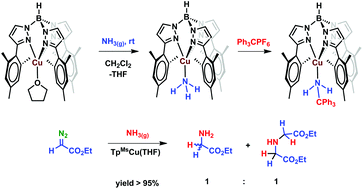
Dalton Trans., 2016,45, 14628-14633
https://doi.org/10.1039/C5DT04972E
Electrocatalytic reduction of CO2 by thiophene-substituted rhenium(I) complexes and by their polymerized films
Three novel Re complexes with thiophene substituted bipyridine ligands were electropolymerized on GCE surface by oxidation. The surface-modified electrodes were tested for electrocatalytic CO2 reduction.

Dalton Trans., 2016,45, 14678-14688
https://doi.org/10.1039/C5DT04491J
About this collection
Small molecule activation constitutes one of the main frontiers of inorganic and organometallic chemistry, with much effort directed towards the development of new processes for the selective and sustainable transformation of abundant small molecules such as H2O, NH3, N2, O2, CO, or CO2 into high-value chemical feedstocks and energy resources.
This themed issue focuses on homogenously catalysed activation of small molecules, as well as stoichiometric reactions that further our understanding towards such ends. The manuscripts included cover many aspects of small molecule activation including: organometallic chemistry, (electro)catalysis, photochemistry, mechanistic studies, spectroscopy, synthesis, and developments in materials science.